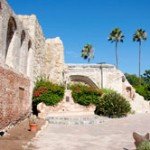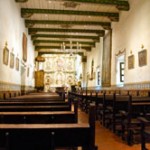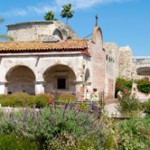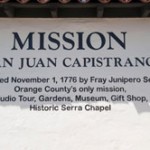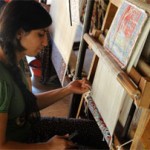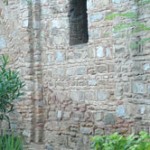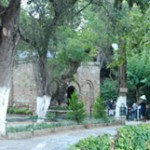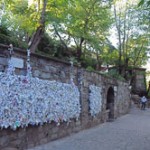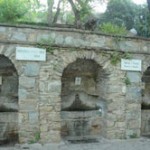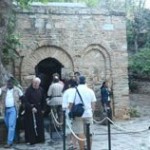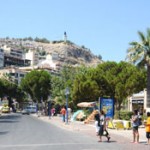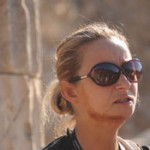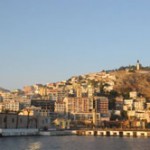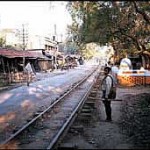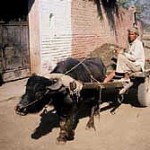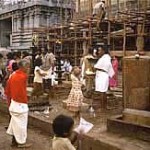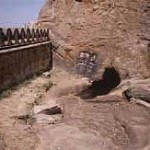August 12, 2009
Yesterday I made a wonderful trip to one the most prominent California missions, Mission San Juan Capistrano, which is located about 100 kilometers south of Los Angeles. To give you a little background on what the missions are, I quote the opening paragraph from the Wikipedia:
“The Spanish missions in California comprise a series of religious outposts established by Spanish Catholics of the Franciscan Order between 1769 and 1823 to spread the Christian faith among the local Native Americans. The missions represented the first major effort by Europeans to colonize the Pacific Coast region, and gave Spain a valuable toehold in the frontier land. The settlers introduced European livestock, fruits, vegetables, and industry into the California region… Today, the missions are among the state’s oldest structures and the most-visited historic monuments.”
The Capitsrano mission is located immediately off the 5 freeway at the Ortega Highway exit and anyone who is traveling between San Diego and Los Angeles, and who is interested in California history and religion, should stop and take a tour. This is a must see site. From my travels in Europe I have gained a keen sense of living and dead historical sites and this one is definitely living. Its ruins go back almost 300 years and for the western coast of North America this, indeed, is ‘ancient.’ The local community, San Juan Capistrano, is in one of the best areas of Orange County and even though the Mission has become a tourist location, the local city keeps the surrounding area tasteful. There is nothing tacky here. Walking into the mission one is immediately swept up by its peacefulness and serenity. This Capistrano mission is an oasis of spiritual serenity. It is a place where you can sit and “recharge,” and when I sat in the main courtyard facing the central fountain and the gardens, I could immediately feel the calm and spirituality of the mission wash over me. One can successfully make a tour of this place in about two hours, but I would allow at least 15 minutes to just sit and feel the ambience. There is an excellent walking audio tour that I recommend, which gives the history of the various rooms and activity centers. Listening to these sound bites one learns a lot about the history and what life in the California frontier must have been like. The highlight of my visit was the Serra Church with its 300 year old Spanish baroque altar, and the ruins of the Great Stone Church. See the photos. The Serra Church is a living place of worship with mass everyday at 7AM, and without a doubt it is the engine that keeps the mission alive and spiritually potent. The ruins of The Great Stone Church, which is actually a basilica, are just remnants from the past because the original structure was destroyed during an earthquake in 1812. Over 40 worshippers died in this disaster, which occurred only ten years after the church was completed. This church is sometimes called the American Acropolis, but having seen the Athen’s acropolis, there is no comparison. Regardless, the ruins are impressive in their own right and give a solid indication of what a magnificent structure this place once was.
The curious thing is that this grand structure is completely out of sync with the religious mood of the mission. Today, the mission is a peaceful, serene, and rustic spiritual retreat, a spiritual oasis in the heart of a high-tech and upbeat modern world. The presence of a basilica in the midst of this rustic simplicity seems out of place. To make a Hindu comment on this matter, we think of worship as a form of meditation that produces a certain “flavor” or “taste.” This is called rasa. Worship in a grand way, as one would find in a large basilica, produces another state of mind that contemplates the divine in a majestic way. Majesty produces a particular kind religious “taste.” Take the example of the Vatican in Rome. There one finds a kind of imperial Christianity. Christ is worshipped in a majestic way with huge basilicas adorned with gold and silver, precious gems, gorgeous paintings and other priceless works of art. You can see a similar kind of worship in many large Hindu temples in India. As you enter these grand imperial “palaces” you get the feeling that you are approaching God as the “King of the Universe.” One is over powered by the grander of the architecture and the opulence of the art. This is the worship of the divine following the way of majesty. In Hinduism this is called Aisvarya, the “majestic way.” But there are other ways to worship. Take the worship of Krishna in the rustic village of Vrindavan, which is the “birth-site” of Krishna. Instead of seeing huge temples and opulent styles or worship, which is what you may expect, one finds simple and rustic temples with very little opulence. In Vrindavan Krishna is worshipped in a rustic simplicity that produces a sweetness and intimacy that is distinct from the majestic way. In Hinduism this sweet way of worship is called madhurya, the worship of the divine with simplicity and spontaneity. The mission at San Juan Capistrano follows this sweet mode and you feel it everywhere. It is simple village life built around the worship of God, and the Serra Church perfectly embodies this approach. The Great Stone Church, on the other hand, follows the majestic way and seems completely out of sync or in contrary religious “taste” with the mood of this mission. From this perspective the loss of The Great Stone church has preserved the sweet mode of worship that can be found at Mission San Juan Capistrano. I will return for the 7AM mass one day.
- View of the ruins of the Great Stone Church
- Inside the Serra Church
- View from the central courtyard
- Street plate describing the mission
- View of the ruins of the Great Stone Church
Click here for more photos

